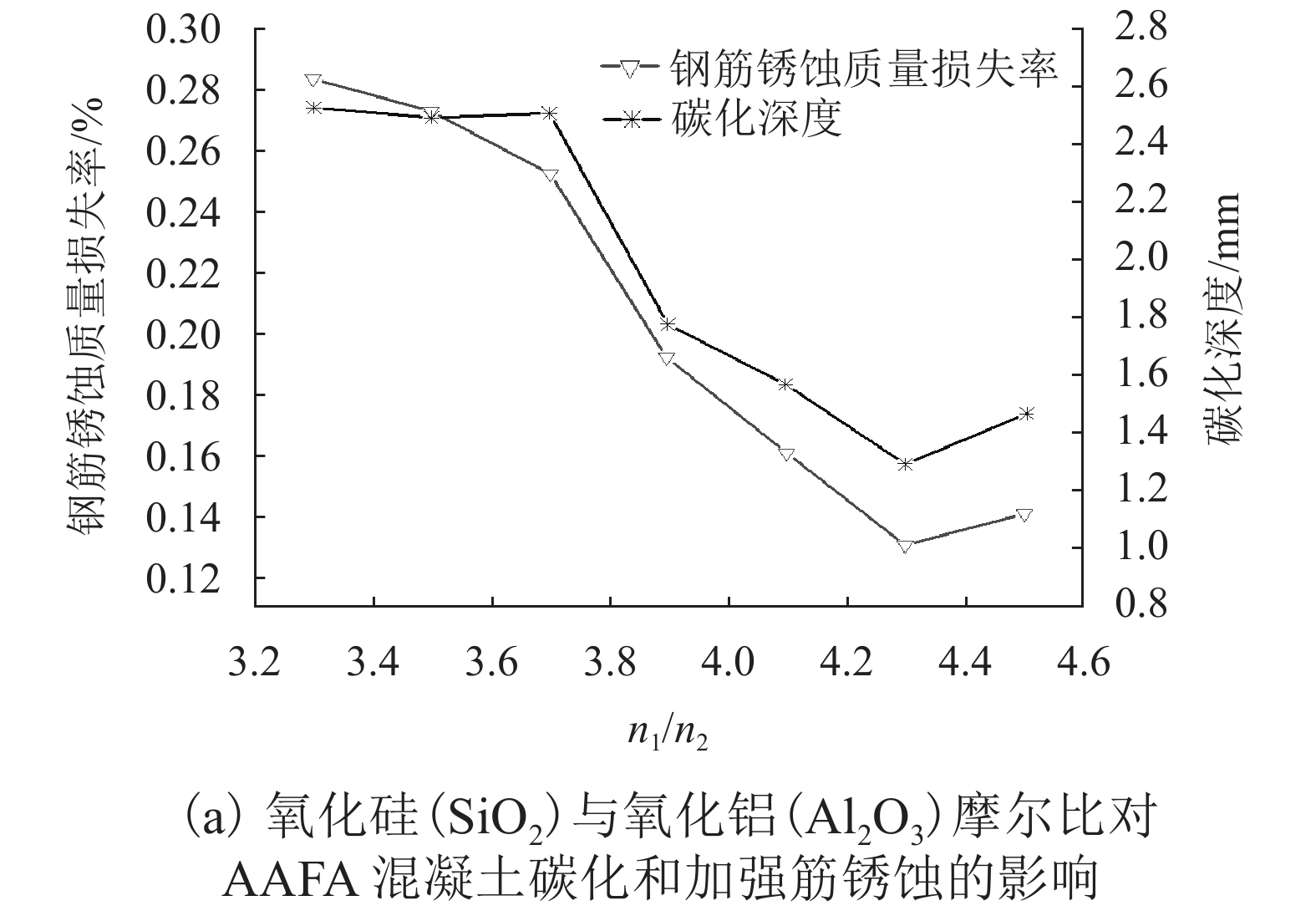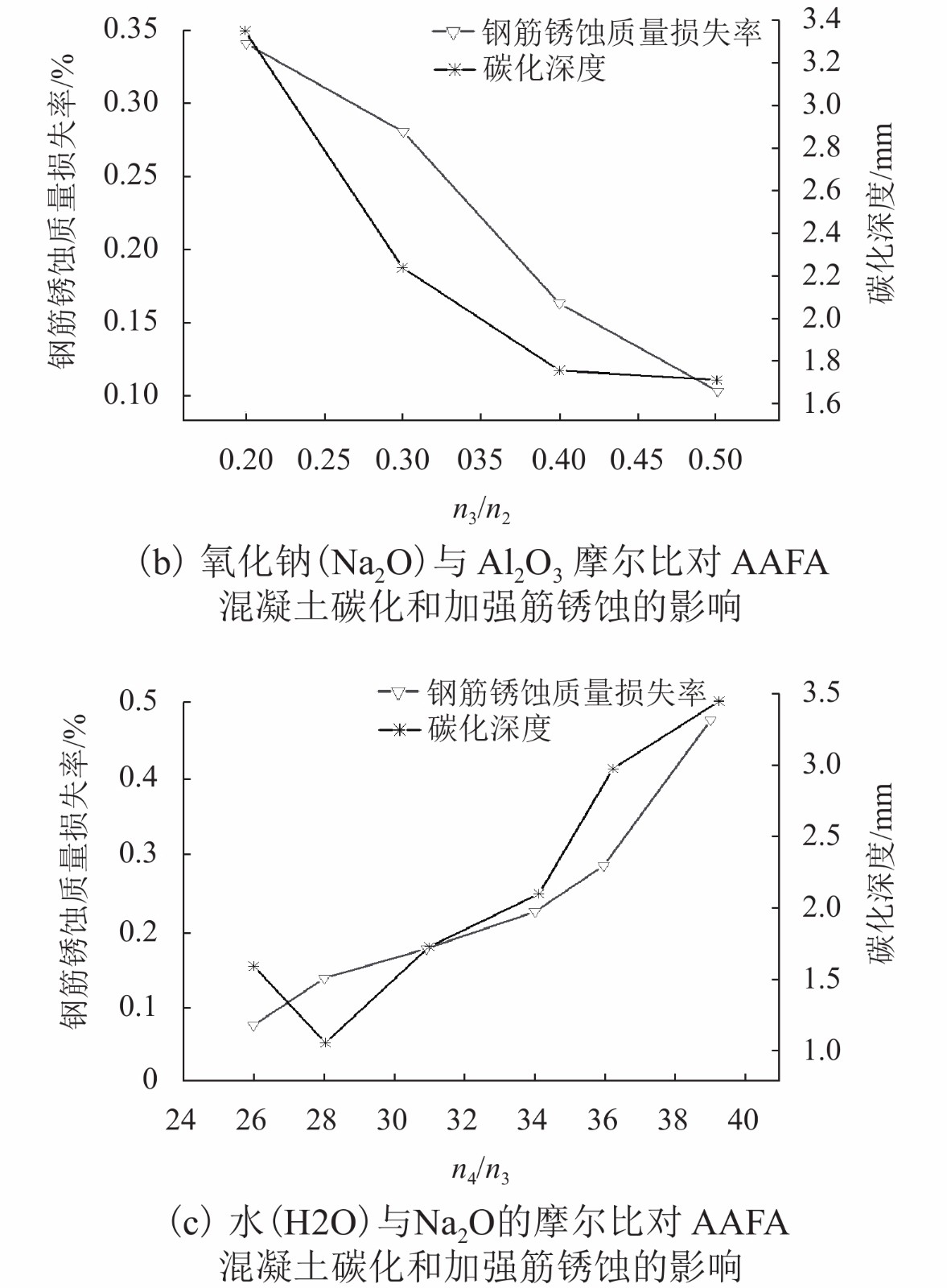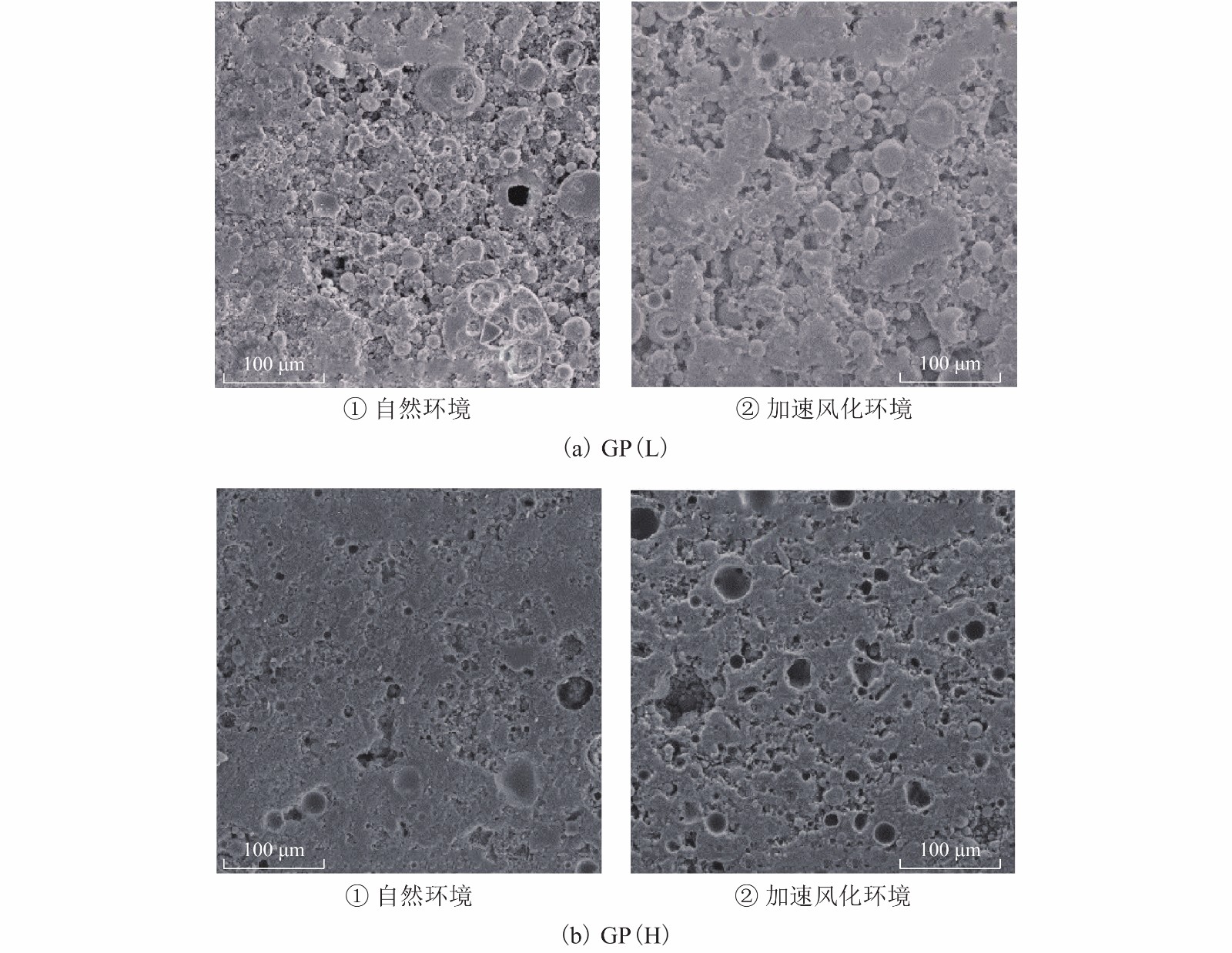|
LAW D W, ADAM A A, MOLYNEAUX T K, et al. Long term durability properties of class F fly ash geopolymer concrete[J]. Materials and Structures, 2015, 48(3): 721-31. doi: 10.1617/s11527-014-0268-9
|
|
DAVIDOVIT S J. Green chemistry and sustainable development solutions[C]//Geopolymer, Green Chemistry and Sustainable Development Solutions: Proceedings of the World Congress Geopolymer 2005. Perancis: Geopolymer Institute, 2005: 9-15.
|
|
BADAR M S, KUPWADE-PATIL K, BERNAL S A, et al. Corrosion of steel bars induced by accelerated carbonation in low and high calcium fly ash geopolymer concretes[J]. Construction and Building Materials, 2014, 61: 79-89. doi: 10.1016/j.conbuildmat.2014.03.015
|
|
BERNAL S A, PROVIS J L, WALKLEY B, et al. Gel nanostructure in alkali-activated binders based on slag and fly ash,and effects of accelerated carbonation[J]. Cement and Concrete Research, 2013, 53: 127-144. doi: 10.1016/j.cemconres.2013.06.007
|
|
PASUPATHY K, BERNDT M, SANJAYAN J, et al. Durability of low-calcium fly ash based geopolymer concrete culvert in a saline environment[J]. Cement and Concrete Research, 2017, 100: 297-310. doi: 10.1016/j.cemconres.2017.07.010
|
|
CRIADO M, PALOMO A, FERNÁNDEZ-JIMÉNEZ A. Alkali activation of fly ashes. part 1:effect of curing conditions on the carbonation of the reaction products[J]. Fuel Guildford, 2005, 84(16): 2048-2054. doi: 10.1016/j.fuel.2005.03.030
|
|
PASUPATHY K, BERNDT M, CASTEL A, et al. Carbonation of a blended slag-fly ash geopolymer concrete in field conditions after 8 years[J]. Construction and Building Materials, 2016, 125: 661-669. doi: 10.1016/j.conbuildmat.2016.08.078
|
|
KHAN M S H, CASTEL A, NOUSHINI A. Carbonation of a low-calcium fly ash geopolymer concrete[J]. Magazine of Concrete Research, 2017, 69(1): 24-34. doi: 10.1680/jmacr.15.00486
|
|
WANG Q, DA J, ZHANG C B, et al. Influence of composition on the corrosion of steel bar of reinforced geopolymer concrete[J]. Applied Mechanics and Materials, 2012, 1620: 536-541. doi: 10.4028/www.scientific.net/AMM.152-154.536
|
|
HUANG G, JI Y, LI J, et al. Use of slaked lime and Portland cement to improve the resistance of MSWI bottom ash-GBFS geopolymer concrete against carbonation[J]. Construction and Building Materials, 2018, 166: 290-300. doi: 10.1016/j.conbuildmat.2018.01.089
|
|
DUAN P, YAN C, LUO W, et al. Effects of adding nano-TiO2 on compressive strength,drying shrinkage,carbonation and microstructure of fluidized bed fly ash based geopolymer paste[J]. Construction and Building Materials, 2016, 106: 115-125. doi: 10.1016/j.conbuildmat.2015.12.095
|
|
ADAM A, MOLYNEAUX T, PATNAIKUNI I, et al. Chloride penetration and carbonation in blended OPC-GGBS, alkali activated slag, and fly ash based geopolymer concrete[C]//Proceedings of the Concrete 09, 24th Biennial Conference of Concrete Institute of Australia. Sydney: Concrete Institute of Australia, 2009: 17-19.
|
|
ADAM A, MOLYNEAUX T, PATNAIKUNI I, et al. Challenges, opportunities and solutions in structural engineering and construction[M]. Las Vegas: CRC Press, 2010: 563-568.
|
|
LI Z G, LI S. Carbonation resistance of fly ash and blast furnace slag based geopolymer concrete[J]. Construction and Building Materials, 2018, 163: 668-680. doi: 10.1016/j.conbuildmat.2017.12.127
|
|
ZHAO R, YUAN Y, CHENG Z, et al. Freeze-thaw resistance of class F fly ash-based geopolymer concrete[J]. Construction and Building Materials, 2019, 222: 474-483. doi: 10.1016/j.conbuildmat.2019.06.166
|
|
VÁCHAL T, ŠULC R, SVOBODA P. Freeze-thaw resistance with sodium chloride solution of fly-ash concrete mixtures[J]. Advanced Materials Research, 2015, 1124: 137-144. doi: 10.4028/www.scientific.net/AMR.1124.137
|
|
SUN P, WU H C. Chemical and freeze-thaw resistance of fly ash-based inorganic mortars[J]. Fuel, 2013, 111: 740-745. doi: 10.1016/j.fuel.2013.04.070
|
|
CAI L, WANG H, FU Y. Freeze–thaw resistance of alkali-slag concrete based on response surface methodology[J]. Construction and Building Materials, 2013, 49: 70-76. doi: 10.1016/j.conbuildmat.2013.07.045
|
|
SHAHRAJABIAN F, BEHFARNIA K. The effects of nano particles on freeze and thaw resistance of alkali-activated slag concrete[J]. Construction and Building Materials, 2018, 176: 172-178. doi: 10.1016/j.conbuildmat.2018.05.033
|
|
LI Q, CAI L, FU Y, et al. Fracture properties and response surface methodology model of alkali-slag concrete under freeze–thaw cycles[J]. Construction and Building Materials, 2015, 93: 620-626. doi: 10.1016/j.conbuildmat.2015.06.037
|
|
LI Q. Fracture theory under freeze-thaw cycles and freeze-thaw resistance of alkali-slag concrete[M]. New York: IntechOpen, 2016: 43-62.
|
|
FU Y, CAI L, WU Y. Freeze-thaw cycle test and damage mechanics models of alkali-activated slag concrete[J]. Construction and Building Materials, 2011, 25(7): 3144-3148. doi: 10.1016/j.conbuildmat.2010.12.006
|
|
GIFFORD P M, GILLOTT J E. Freeze-thaw durability of activated blast furnace slag cement concrete[J]. ACI Materials Journal, 1996, 93(3): 242-245.
|
|
ALLAHVERDI A, ABADI M, HOSSAIN K, et al. Resistance of chemically-activated high phosphorous slag content cement against freeze–thaw cycles[J]. Cold Regions Science and Technology, 2014, 103: 107-114. doi: 10.1016/j.coldregions.2014.03.012
|
|
ZHAO M, ZHANG G, HTET K W, et al. Freeze-thaw durability of red mud slurry-class F fly ash-based geopolymer:Effect of curing conditions[J]. Construction and Building Materials, 2019, 215: 381-390. doi: 10.1016/j.conbuildmat.2019.04.235
|
|
ZHU H, ZHANG Z, ZHU Y, et al. Durability of alkali-activated fly ash concrete:chloride penetration in pastes and mortars[J]. Construction and Building Materials, 2014, 65: 51-59. doi: 10.1016/j.conbuildmat.2014.04.110
|
|
HALIM L N, EKAPUTRI J J. The influence of salt water on chloride penetration in geopolymer concrete[J]. MATEC Web of Conferences, 2017: 01002.1-01002.5.
|
|
PARTHASARATHY P, HANIF A, SHAO H, et al. microstructural and morphological studies of ordinary portland cement paste and fly ash based geopolymer in the presence of chloride ions[C]//71st RILEM Week and ICACMS 2017-International Conference on Advances in Construction Materials and Systems. Chennai: ACM, 2017: 623-630.
|
|
MONTICELLI C, NATALI M, BALBO A, et al. A study on the corrosion of reinforcing bars in alkali-activated fly ash mortars under wet and dry exposures to chloride solutions[J]. Cement and Concrete Research, 2016, 87: 53-63. doi: 10.1016/j.cemconres.2016.05.010
|
|
CHINDAPRASIRT P, CHALEE W. Effect of sodium hydroxide concentration on chloride penetration and steel corrosion of fly ash-based geopolymer concrete under marine site[J]. Construction and Building Materials, 2014, 63: 303-310. doi: 10.1016/j.conbuildmat.2014.04.010
|
|
NOUSHINI A, CASTEL A, ALDRED J, et al. Chloride diffusion resistance and chloride binding capacity of fly ash-based geopolymer concrete[J]. Cement and Concrete Composites, 2020, 105: 103290.1-103290.6.
|
|
THOMAS R, ARIYACHANDRA E, LEZAMA D, et al. Comparison of chloride permeability methods for alkali-activated concrete[J]. Construction and Building Materials, 2018, 165: 104-111. doi: 10.1016/j.conbuildmat.2018.01.016
|
|
TENNAKOON C, SHAYAN A, SANJAYAN J G, et al. Chloride ingress and steel corrosion in geopolymer concrete based on long term tests[J]. Materials & Design, 2017, 116: 287-299.
|
|
RAJAMANE N, NATARAJA M, LAKSHMANAN N, et al. Rapid chloride permeability test on geopolymer and Portland cement concretes[J]. The Indian Concrete Journal, 2011, 85(10): 21-26.
|
|
LEE N, LEE H K. Influence of the slag content on the chloride and sulfuric acid resistances of alkali-activated fly ash/slag paste[J]. Cement and Concrete Composites, 2016, 72: 168-179. doi: 10.1016/j.cemconcomp.2016.06.004
|
|
YANG T, YAO X, ZHANG Z. Quantification of chloride diffusion in fly ash-slag-based geopolymers by X-ray fluorescence (XRF)[J]. Construction and Building Materials, 2014, 69: 109-115. doi: 10.1016/j.conbuildmat.2014.07.031
|
|
ISMAIL I, BERNAL S A, PROVIS J L, et al. Influence of fly ash on the water and chloride permeability of alkali-activated slag mortars and concretes[J]. Construction and Building Materials, 2013, 48: 1187-1201. doi: 10.1016/j.conbuildmat.2013.07.106
|
|
JUN Y, YOON S, OH J. A comparison study for chloride-binding capacity between alkali-activated fly ash and slag in the use of seawater[J]. Applied Sciences, 2017, 7(10): 971-984. doi: 10.3390/app7100971
|
|
WALLAH S E, HARDJITO D, SUMAJOUW D M, et al. Performance of fly ash based geopolymer concrete under sulfate and acid exposure[C]//Geopolymer, Green Chemistry and Sustainable Development Solutions: Proceedings of the World Congress Geopolymer 2005. Saint Quentin: Geopolymer Institute, 2005: 153-156.
|
|
WALLAH S E, HARDJITO D, SUMAJOUW D M J, et al. Sulfate and acid resistance of fly ash-based geopolymer concrete[C]//Australian Structural Engineering Conference 2005. Sydney: Engineers Australia, 2005: 733-742.
|
|
SATA V, SATHONSAOWAPHAK A, CHINDAPRASIRT P. Resistance of lignite bottom ash geopolymer mortar to sulfate and sulfuric acid attack[J]. Cement and Concrete Composites, 2012, 34(5): 700-708. doi: 10.1016/j.cemconcomp.2012.01.010
|
|
ARIFFIN M, BHUTTA M, HUSSIN M, et al. Sulfuric acid resistance of blended ash geopolymer concrete[J]. Construction and Building Materials, 2013, 43: 80-86. doi: 10.1016/j.conbuildmat.2013.01.018
|
|
IZZAT A M, AL BAKRI A M M, KAMARUDIN H, et al. Microstructural analysis of geopolymer and ordinary Portland cement mortar exposed to sulfuric acid[J]. Materiale Plastice, 2013, 50(3): 171-174.
|
|
SONG X J, MAROSSZEKY M, BRUNGS M, et al. Durability of fly ash based geopolymer concrete against sulphuric acid attack[C]//International Conference On Durability of Building Materials and Components. Lyon: Panini, 2005: 17-20.
|
|
KANNAPIRAN K, SUJATHA T, NAGAN S. Resistance of reinforced geopolymer concrete beams to acid and chloride migration[J]. Asian Journal of Civil Engineering, 2013, 14(2): 225-238.
|
|
AIKEN T A, KWASNY J, SHA W, et al. Effect of slag content and activator dosage on the resistance of fly ash geopolymer binders to sulfuric acid attack[J]. Cement and Concrete Research, 2018, 111: 23-40. doi: 10.1016/j.cemconres.2018.06.011
|
|
MEHTA A, SIDDIQUE R. Sulfuric acid resistance of fly ash based geopolymer concrete[J]. Construction and Building Materials, 2017, 146: 136-143. doi: 10.1016/j.conbuildmat.2017.04.077
|
|
DEB P S, SARKER P K, BARBHUIYA S. Sorptivity and acid resistance of ambient-cured geopolymer mortars containing nano-silica[J]. Cement and Concrete Composites, 2016, 72: 235-245. doi: 10.1016/j.cemconcomp.2016.06.017
|
|
WALLAH S E, HARDJITO D, SUMAJOUW D M J, et al. Geopolymer concrete: a key for better long-term performance and durability[C]//Proc. ICFRC Inter. Conf. on Fiber Composites, High performance Concrete and Smart Materials. Chenni: IOP Publishing, 2004: 527-539.
|
|
CHINDAPRASIRT P, RATTANASAK U, TAEBUANHUAD S. Resistance to acid and sulfate solutions of microwave-assisted high calcium fly ash geopolymer[J]. Materials and Structures, 2013, 46(3): 375-381. doi: 10.1617/s11527-012-9907-1
|
|
NGUYEN K T, LEE Y H, LEE J, et al. Acid resistance and curing properties for green fly ash-geopolymer concrete[J]. Journal of Asian Architecture and Building Engineering, 2013, 12(2): 317-322. doi: 10.3130/jaabe.12.317
|
|
SREEVIDYA V, ANURADHA R, DINAKAR D, et al. Acid resistance of flyash based geopolymer mortar under ambient curing and heat curing[J]. International Journal of Engineering Science and Technology, 2012, 4(2): 681-684.
|
|
SONG X. Development and performance of class F fly ash based geopolymer concretes against sulphuric acid attack[D]. Sydney: The University of New South Wales, 2007.
|
|
TEMUUJIN J, MINJIGMAA A, LEE M, et al. Characterisation of class F fly ash geopolymer pastes immersed in acid and alkaline solutions[J]. Cement and Concrete Composites, 2011, 33(10): 1086-1091. doi: 10.1016/j.cemconcomp.2011.08.008
|
|
THOKCHOM S, GHOSH P, GHOSH S. Durability of fly ash geopolymer mortars in nitric acid-effect of alkali (Na2O) content[J]. Journal of Civil Engineering and Management, 2011, 17(3): 393-399. doi: 10.3846/13923730.2011.594225
|
|
THOKCHOM S. International Journal of Engineering Innovations and Research[J]. International Journal of Engineering Innovations and Research, 2014, 3(6): 943-947.
|
|
THOKCHOM S, GHOSH P, GHOSH S. Resistance of fly ash based geopolymer mortars in sulfuric acid[J]. Asian Research Publishing Network (ARPN), 2009, 4(1): 36-40.
|
|
THOKCHOM S, GHOSH P, GHOSH S. Effect of Na2O content on durability of geopolymer mortars in sulphuric acid[J]. World Academy of Science,Engineering and Technology, 2009, 3: 508-513.
|
|
BAKHAREV T. Resistance of geopolymer materials to acid attack[J]. Cement and Concrete Research, 2005, 35(4): 658-670. doi: 10.1016/j.cemconres.2004.06.005
|
|
DUAN P, YAN C, ZHOU W, et al. An investigation of the microstructure and durability of a fluidized bed fly ash-metakaolin geopolymer after heat and acid exposure[J]. Materials & Design, 2015, 74: 125-137.
|
|
CHINDAPRASIRT P, PAISITSRISAWAT P, RATTANASAK U. Strength and resistance to sulfate and sulfuric acid of ground fluidized bed combustion fly ash-silica fume alkali-activated composite[J]. Advanced Powder Technology, 2014, 25(3): 1087-1093. doi: 10.1016/j.apt.2014.02.007
|
|
LUHAR S, KHANDELWAL U. A study on water absorption and sorptivity of geopolymer concrete[J]. International Journal of Civil Engineering, 2015, 2(8): 1-10.
|
|
FARHANA Z F, KAMARUDIN H, RAHMAT A, et al. The relationship between water absorption and porosity for geopolymer paste[J]. Materials Science Forum, 2014, 803: 166-172. doi: 10.4028/www.scientific.net/MSF.803.166
|
|
MISHRA A, CHOUDHARY D, JAIN N, et al. Effect of concentration of alkaline liquid and curing time on strength and water absorption of geopolymer concrete[J]. Journal of Engineering and Applied Sciences, 2008, 3(1): 14-18.
|
|
NAZARI A, SANJAYAN J G. Hybrid effects of alumina and silica nanoparticles on water absorption of geopolymers:application of taguchi approach[J]. Measurement, 2015, 60: 240-246. doi: 10.1016/j.measurement.2014.10.004
|
|
HUSEIEN G F, MIRZA J, ISMAIL M, et al. The effect of sodium hydroxide molarity and other parameters on water absorption of geopolymer mortars[J]. Indian Journal of Science and Technology, 2016, 9(48): 1-7.
|
|
KUMAR E M, RAMAMURTHY K. Influence of production on the strength,density and water absorption of aerated geopolymer paste and mortar using class F fly ash[J]. Construction and Building Materials, 2017, 156: 1137-1149. doi: 10.1016/j.conbuildmat.2017.08.153
|
|
NAZARI A, RIAHI S. Experimental investigations and ANFIS prediction of water absorption of geopolymers produced by waste ashes[J]. Journal of Non-Crystalline Solids, 2012, 358(1): 40-46. doi: 10.1016/j.jnoncrysol.2011.08.022
|
|
NAZARI A. Experimental study and computer-aided prediction of percentage of water absorption of geopolymers produced by waste fly ash and rice husk bark ash[J]. International Journal of Mineral Processing, 2012, 110: 74-81.
|
|
NAZARI A. Artificial neural networks for prediction of percentage of water absorption of geopolymers produced by waste ashes[J]. Bulletin of Materials Science, 2012, 35(6): 1019-1029. doi: 10.1007/s12034-012-0380-9
|
|
ZHANG Z, PROVIS J L, MA X, et al. Efflorescence and subflorescence induced microstructural and mechanical evolution in fly ash-based geopolymers[J]. Cement and Concrete Composites, 2018, 92: 165-177. doi: 10.1016/j.cemconcomp.2018.06.010
|
|
ZHANG Z, PROVIS J L, REID A, et al. Fly ash-based geopolymers:the relationship between composition,pore structure and efflorescence[J]. Cement and Concrete Research, 2014, 64: 30-41. doi: 10.1016/j.cemconres.2014.06.004
|
|
GHOSH R, GUPTA S K, KUMAR A, et al. Leaching and efflorescence effects in geopolymer concrete[J]. Journal of Metallurgy and Materials Science, 2018, 60(2): 79-88.
|
|
YAO X, YANG T, ZHANG Z. Compressive strength development and shrinkage of alkali-activated fly ash-slag blends associated with efflorescence[J]. Materials and Structures, 2016, 49(7): 2907-2918. doi: 10.1617/s11527-015-0694-3
|
|
YAO X, YANG T, ZHANG Z. Fly ash-based geopolymers:effect of slag addition on efflorescence[J]. Journal of Wuhan University of Technology (Mater. Sci. Ed), 2016, 31(3): 689-694. doi: 10.1007/s11595-016-1430-8
|
|
ZHANG Z, WANG H, PROVIS J L, et al. Efflorescence: a critical challenge for geopolymer applications[C]//Concrete Institute of Australia’s Biennial National Conference 2013. Queensland: Concrete Institute of Australia, 2013: 1-10.
|
|
ŠKVÁRA F, KOPECKÝ L, MYŠKOVÁ L, et al. Aluminosilicate polymers-influence of elevated temperatures,efflorescence[J]. Ceramics-Silikáty, 2009, 53(4): 276-282.
|
|
KIM B, HEO Y E, CHON C M, et al. Influence of Na/Al ratio and curing temperature of geopolymers on efflorescence reduction[J]. Journal of the Korean Institute of Resources Recycling, 2018, 27(6): 59-67.
|
|
ZHANG Z, PROVIS J L, WANG H. Critical thinking on efflorescence in alkali activated cement (AAC)[C]//Proceedings of the International Conference on Performance-based and Life-cycle Structural Engineering. Sydney: Atlantis Press, 2015: 147-153.
|
|
LEE S, CHON C M, KIM B. Effect of geopolymer composition and curing conditions on efflorescence in lightweight porous geopolymers[C]//International Conference on Alkali Activated Materials and Geopolymers: Versatile Materials Offering High Performance and Low Emissions. Tomar: Australian Academic Press, 2018: 76-82.
|
|
WANG J, ZHOU T, XU D, et al. Effect of nano-silica on the efflorescence of waste based alkali-activated inorganic binder[J]. Construction and Building Materials, 2018, 167: 381-390. doi: 10.1016/j.conbuildmat.2018.02.006
|
|
XUE X, LIU Y L, DAI J G, et al. Inhibiting efflorescence formation on fly ash-based geopolymer via silane surface modification[J]. Cement and Concrete Composites, 2018, 94: 43-52. doi: 10.1016/j.cemconcomp.2018.08.013
|






 下载:
下载:



